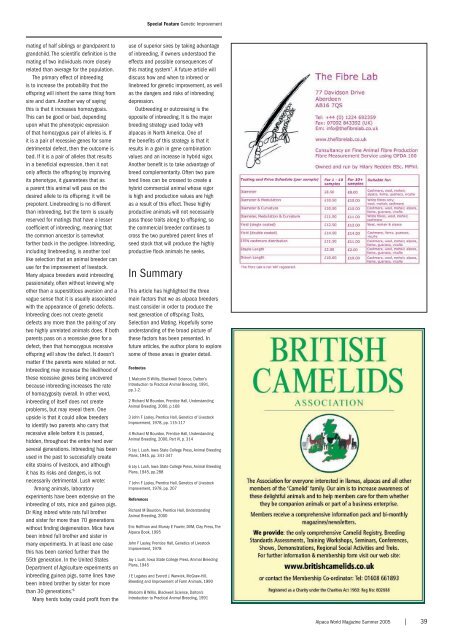Alpaca World Magazine Summer 2005 - Classical MileEnd Alpacas
Alpaca World Magazine Summer 2005 - Classical MileEnd Alpacas
Alpaca World Magazine Summer 2005 - Classical MileEnd Alpacas
- No tags were found...
You also want an ePaper? Increase the reach of your titles
YUMPU automatically turns print PDFs into web optimized ePapers that Google loves.
Special Feature Genetic Improvementmating of half siblings or grandparent tograndchild. The scientifi c defi nition is themating of two individuals more closelyrelated than average for the population.The primary effect of inbreedingis to increase the probability that theoffspring will inherit the same thing fromsire and dam. Another way of sayingthis is that it increases homozygosis.This can be good or bad, dependingupon what the phenotypic expressionof that homozygous pair of alleles is. Ifit is a pair of recessive genes for somedetrimental defect, then the outcome isbad. If it is a pair of alleles that resultsin a benefi cial expression, then it notonly affects the offspring by improvingits phenotype, it guarantees that asa parent this animal will pass on thedesired allele to its offspring; it will beprepotent. Linebreeding is no differentthan inbreeding, but the term is usuallyreserved for matings that have a lessercoeffi cient of inbreeding, meaning thatthe common ancestor is somewhatfarther back in the pedigree. Inbreeding,including linebreeding, is another toollike selection that an animal breeder canuse for the improvement of livestock.Many alpaca breeders avoid inbreedingpassionately, often without knowing whyother than a superstitious aversion and avague sense that it is usually associatedwith the appearance of genetic defects.Inbreeding does not create geneticdefects any more than the pairing of anytwo highly unrelated animals does. If bothparents pass on a recessive gene for adefect, then that homozygous recessiveoffspring will show the defect. It doesn’tmatter if the parents were related or not.Inbreeding may increase the likelihood ofthese recessive genes being uncoveredbecause inbreeding increases the rateof homozygosity overall. In other word,inbreeding of itself does not createproblems, but may reveal them. Oneupside is that it could allow breedersto identify two parents who carry thatrecessive allele before it is passed,hidden, throughout the entire herd overseveral generations. Inbreeding has beenused in the past to successfully createelite strains of livestock, and althoughit has its risks and dangers, is notnecessarily detrimental. Lush wrote:‘Among animals, laboratoryexperiments have been extensive on theinbreeding of rats, mice and guinea pigs.Dr King inbred white rats full brotherand sister for more than 70 generationswithout fi nding degeneration. Mice havebeen inbred full brother and sister inmany experiments. In at least one casethis has been carried further than the55th generation. In the United StatesDepartment of Agriculture experiments oninbreeding guinea pigs, some lines havebeen inbred brother by sister for morethan 30 generations.’ 6Many herds today could profi t from theuse of superior sires by taking advantageof inbreeding, if owners understood theeffects and possible consequences ofthis mating system 7 . A future article willdiscuss how and when to inbreed orlinebreed for genetic improvement, as wellas the dangers and risks of inbreedingdepression.Outbreeding or outcrossing is theopposite of inbreeding. It is the majorbreeding strategy used today withalpacas in North America. One ofthe benefi ts of this strategy is that itresults in a gain in gene combinationvalues and an increase in hybrid vigor.Another benefi t is to take advantage ofbreed complementarity. Often two purebred lines can be crossed to create ahybrid commercial animal whose vigoris high and production values are highas a result of this effect. These highlyproductive animals will not necessarilypass those traits along to offspring, sothe commercial breeder continues tocross the two purebred parent lines ofseed stock that will produce the highlyproductive fl ock animals he seeks.In SummaryThis article has highlighted the threemain factors that we as alpaca breedersmust consider in order to produce thenext generation of offspring: Traits,Selection and Mating. Hopefully someunderstanding of the broad picture ofthese factors has been presented. Infuture articles, the author plans to exploresome of these areas in greater detail.Footnotes1 Malcolm B Willis, Blackwell Science, Dalton’sIntroduction to Practical Animal Breeding, 1991,pp.1-2.2 Richard M Bourdon, Prentice Hall, UnderstandingAnimal Breeding, 2000, p.1683 John F Lasley, Prentice Hall, Genetics of LivestockImprovement, 1978, pp. 115-1174 Richard M Bourdon, Prentice Hall, UnderstandingAnimal Breeding, 2000, Part IV, p. 3145 Jay L Lush, Iowa State College Press, Animal BreedingPlans, 1945, pp. 341-3476 Jay L Lush, Iowa State College Press, Animal BreedingPlans, 1945, pp.2887 John F Lasley, Prentice Hall, Genetics of LivestockImprovement, 1978, pp. 207ReferencesRichard M Bourdon, Prentice Hall, UnderstandingAnimal Breeding, 2000Eric Hoffman and Murray E Fowler, DVM, Clay Press, The<strong>Alpaca</strong> Book, 1995John F Lasley, Prentice Hall, Genetics of LivestockImprovement, 1978Jay L Lush, Iowa State College Press, Animal BreedingPlans, 1945J E Legates and Everett J. Warwick, McGraw-Hill,Breeding and Improvement of Farm Animals, 1990Malcolm B Willis, Blackwell Science, Dalton’sIntroduction to Practical Animal Breeding, 1991<strong>Alpaca</strong> <strong>World</strong> <strong>Magazine</strong> <strong>Summer</strong> <strong>2005</strong> | 39







